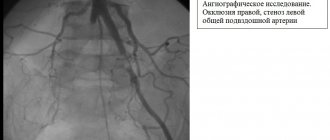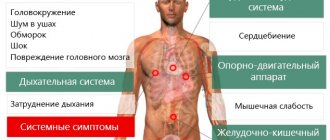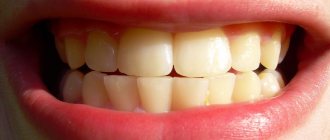Causes of high blood pressure
Physiological factors
A short-term increase in blood pressure is observed when the sympathoadrenal system is activated.
This happens under stress and severe fear. Blood pressure increases moderately and is not accompanied by a serious deterioration in health. After eliminating the traumatic factor, the condition returns to normal. During fever, the tonometer readings also change, their increase is proportional to the level of body temperature. A widespread phenomenon is “white coat syndrome.” When measuring blood pressure in a medical facility (for example, during a medical examination), its level exceeds the norm. This is explained by the excitement and nervousness that the patient experiences when seeing medical workers. At the same time, self-monitoring of pressure at home does not show deviations from the norm. It is believed that the presence of such a syndrome increases the risk of developing hypertension in the future.
Arterial hypertension
Primary arterial hypertension is the most common pathological cause of high blood pressure. Problems with blood pressure mainly begin after 50 years of age. When measured with a tonometer, values above 140/90 mm Hg are obtained. Art. Registration of proportionally increased systolic and diastolic pressure is typical. The diagnosis of arterial hypertension is established if the indicated values were obtained from 3 independent measurements.
Cardiovascular diseases
An increase in systolic pressure is a typical manifestation of atherosclerosis. For coarctation of the aorta, the presence of elevated blood pressure in both arms is more specific; when measuring values in the legs, normal values are obtained. Upon visual examination, there is noticeable good development of the muscles of the arms and torso with relatively short and weak lower limbs.
Blood pressure increases with Takayasu's disease (nonspecific aortoarteritis). A pathognomonic sign is that increased blood pressure is recorded on the arm and leg of one half of the body, while on the other side the level remains normal. Symptoms appear in young patients, most often between 15 and 30 years. Hypertension is observed with stenosis of the carotid and vertebrobasilar arteries, aortic valve insufficiency, and complete atrioventricular block.
Kidney diseases
The presence of a symptom in case of kidney damage is associated with an increased release of vasoconstrictor factors into the blood, retention of water and salts in the tissues. Renal forms of hypertension are characterized by the presence of sharply increased diastolic pressure (up to 110 mm Hg and higher) with a relatively small increase in systolic pressure. A similar clinical picture often occurs in young and middle-aged patients. Several groups of diseases contribute to the appearance of high blood pressure:
- Diseases of the renal parenchyma
: chronic glomerulonephritis and pyelonephritis, diabetic glomerulosclerosis, amyloidosis. - Renal vascular damage
: atherosclerotic stenosis of the renal artery, fibromuscular dysplasia. - Congenital anomalies
: polycystic disease, hypoplasia, horseshoe kidney.
Endocrine disorders
Periodic sharp fluctuations in blood pressure occur in women with complicated menopause. The symptom is accompanied by intense redness of the skin and sweating. It is caused by hormonal changes in the body, disorders of the autonomic innervation of vascular tone. Hormones play a big role in regulating blood pressure, so its increase is provoked by the following endocrine diseases:
- Thyrotoxicosis.
With thyroid pathology, isolated systolic hypertension is recorded, and diastolic blood pressure is normal or even reduced. Tachycardia, finger tremor, hot and dry skin are observed. The pathognomonic symptom is exophthalmos. - Pheochromocytoma.
A tumor of the adrenal medulla is manifested by an increase in pressure to extremely high numbers - from 180/120 mm Hg. Art. Symptoms are usually detected in patients aged 20-40 years. Pheochromocytoma is associated with tachycardia, tachypnea, and severe headache. - Itsenko-Cushing's disease.
There is a persistent increase in pressure that is refractory to drug therapy. Systolic and diastolic pressure increases evenly. A typical combination of high blood pressure with obesity in the upper half of the body, purple stretch marks, and increased hair growth. - Hyperaldosteronism.
It is characterized by a stable and steady increase in blood pressure, which is not relieved by standard medications, in addition to potassium-sparing diuretics. In addition to elevated blood pressure, muscle weakness, functional paresis, and paresthesia are detected.
Preeclampsia in pregnant women
Preeclampsia, which occurs in the second half of pregnancy, is accompanied by an increase in blood pressure over 140/90. Along with hypertension, severe swelling, headaches, and nausea are observed. In the absence of treatment, blood pressure rises to very high levels, visual disturbances and vomiting are added to the symptoms. If convulsions develop against the background of high blood pressure and nephropathy, the condition is said to be transitioning to the stage of eclampsia.
Complications of pharmacotherapy
Fluctuations in blood pressure are one of the most common side effects of drug treatment. Your blood pressure usually changes some time after you start taking the medicine. Exceptions are drugs with sympathomimetic activity, which provoke a sharp jump in blood pressure immediately after use. Complications in the form of high blood pressure are possible when taking the following groups of medications:
- Hormones
: glucocorticoids, oral contraceptives. - Drugs affecting the central nervous system
: MAO inhibitors, tricyclic antidepressants. - Non-steroidal anti-inflammatory drugs
(with long-term use). - Sympathomimetics
: ephedrine, tyramine.
Rare causes
- Pathologies of the central nervous system
: brain tumors and cysts, subarachnoid hemorrhage, meningitis and meningoencephalitis. - Diseases of the blood system
: erythremia, hypercoagulation. - Acute stress
: burn disease, crisis in sickle cell anemia, withdrawal syndrome in alcoholism. - Exogenous intoxications
: lead, thalium, cadmium.
What is blood pressure?
This is an indicator of the amount/force of blood pressure exerted on the walls of blood vessels. When measuring blood pressure with a tonometer, two numbers are taken into account - the lower and upper values. This is the value at the time of maximum tension of the heart muscle (systolic blood pressure or systole) and the value at the moment of its maximum relaxation (diastolic pressure or diastole).
Reference.
Blood pressure (BP) is not a constant value. Pressure readings may vary depending on a number of factors. Even in the same patient, blood pressure fluctuations are observed throughout the day. For example, in the morning after waking up, blood pressure may be low, but in the afternoon it may begin to rise.
Children have lower blood pressure than adults. The risk of developing arterial hypertension increases with age.
The table shows blood pressure standards (by age)
Diagnostics
During the initial examination, the cardiologist performs a physical examination and measures the pressure in the arms and legs. To obtain the most reliable results, 24-hour blood pressure monitoring (ABPM) is prescribed. The diagnostic search is aimed at finding the etiological factors that caused high blood pressure. The examination plan usually includes:
- ECG.
According to the electrocardiogram, signs of myocardial hypertrophy and disturbances in repolarization processes are revealed. When blood pressure changes towards higher levels, single extrasystoles and other rhythm disturbances may occur, and manifestations of congenital or acquired cardiac malformations may be detected. - Ultrasound.
Echocardiography evaluates heart function. Left ventricular myocardial hypertrophy is often visualized. To exclude renal hypertension, an ultrasound of the kidneys and Doppler sonography of the renal arteries are required. According to indications, sonography of the main endocrine glands is performed. - Standard tests
. A general blood test and fasting glucose level are measured. In a biochemical study, the levels of urea and creatinine are studied, the lipid spectrum is the levels of cholesterol, different fractions of lipoproteins. In a general urine test, the amount of protein and cellular elements is determined. - Advanced laboratory tests
. If there are typical symptoms of endocrine pathology, the level of a number of hormones is examined: corticosteroids, aldosterone, catecholamines. To assess renal function, creatinine clearance is calculated. To exclude metabolic syndrome, a glucose tolerance test is recommended. - Additional instrumental studies
. To determine the cardiothoracic index, the shape and size of the heart, a survey radiography of the OGK is performed. To confirm atherosclerotic vascular damage, angiography is performed. For a more detailed study of the structure of the kidneys and adrenal glands, CT and MRI are prescribed.
Prevention of hypertension development
Prevention of arterial hypertension is divided into primary and secondary. Primary prevention is needed for healthy people—those whose blood pressure does not yet exceed normal levels. The following set of health measures will help not only keep your blood pressure normal for many years, but also get rid of excess weight and significantly improve your overall well-being.
Physical exercise
Any physical exercise in persons with mild and moderate hypertension helps to increase physical performance. Exercises aimed at training endurance (general developmental exercises, breathing exercises, exercise equipment, swimming, walking, running) lead to a noticeable antihypertensive effect. However, during intense physical activity, systolic pressure increases sharply, so it is best to exercise a little (30 minutes) each day, gradually increasing the intensity from light to moderate.
Low salt diet
The amount of table salt should be limited to 5 grams (1 teaspoon) per day. It should be noted that many products (cheeses, smoked and pickled products, sausages, canned food, mayonnaise, chips) themselves contain a lot of salt. So remove the salt shaker from the table and never add salt to ready-made dishes. Replace salt with herbs and garlic. If it is difficult to do without salt, you can purchase salt with a reduced sodium content, the taste of which is almost no different from regular salt.
Limiting animal fats
Gradually replace butter, cheeses, sausages, sour cream, lard and fried cutlets from your diet with additional vegetables and fruits, vegetable oil and lean fish. Prefer low-fat dairy products. This way you can control cholesterol levels in the blood (prevention of atherosclerosis), normalize weight and at the same time enrich your diet with potassium, which is very useful for hypertension.
Rejection of bad habits
Enough has been said about the dangers of tobacco and alcohol. But if you find more than two of the risk factors for hypertension listed above, know that it’s time to be more merciful to your heart and blood vessels. Bad habits and arterial hypertension are a terrible combination, which in most cases leads to tragic consequences.
If the diagnosis of “hypertension” has already been made, a few more points should be added to the above measures. This is the so-called secondary prevention, the main task of which is to protect target organs from negative consequences and avoid the dangerous complications of hypertension - coronary heart disease, heart attack, cerebral stroke.
Psychological relief
Stress is one of the main causes of high blood pressure. That’s why it’s so important to master methods of psychological relief - auto-training, self-hypnosis, meditation. It is important to strive to see the positive sides in everything, to find joy in life, to work on your character, changing it towards greater tolerance for other people’s shortcomings, optimism, and balance. Hiking, sports, hobbies and spending time with pets also help maintain mental balance.
Blood pressure measurement
Blood pressure must be measured daily, and the resulting numbers must be written down in a special notebook, which must be shown to your doctor every 2-3 months. Secondary prevention of hypertension consists of individual selection of appropriate doses of antihypertensive drugs and systematic maintenance of normal or near-normal blood pressure values with their help.
Non-drug therapy
In addition to the already mentioned hypertensive diet, therapy may include breathing exercises, light massage, normalization of sleep, adherence to a daily routine, taking natural and synthetic vitamins, antioxidants, nutritional supplements and restorative herbs. In short, it’s worthwhile to “improve” your lifestyle as much as possible.
Treatment
Help before diagnosis
Normalization of elevated blood pressure levels begins with non-drug measures. To reduce the load on the heart, you need to limit the amount of table salt and liquid in your diet. In case of lipid metabolism disorders, exclude animal fats. It is necessary to establish a daily routine: allocate sufficient time for sleep, add feasible physical activity. Drinking alcohol and smoking are completely excluded.
Conservative therapy
Drug treatment is carried out taking into account the etiology of high blood pressure. For symptomatic conditions caused by stress, it is advisable to prescribe sedatives. Thyreostatics are effective in eliminating hypertension in thyrotoxicosis. Most cases of high blood pressure require the use of classical antihypertensive drugs, which in cardiology are divided into 5 groups:
- Diuretics
. Mainly recommended for elderly patients with concomitant heart failure and edema. The products are not used during pregnancy, hypercalcemia, or gout. - ACE inhibitors
. Indicated for high blood pressure in combination with left ventricular dysfunction, diabetes mellitus, and kidney disease. Not prescribed for pregnant women. - II
receptor blockers . According to the mechanism of action, ARBs are similar to the previous group of drugs, but cause fewer undesirable effects. The disadvantage is the high price. - Calcium antagonists
. They have a vasodilating effect, so they are often used when there is a sharp increase in diastolic blood pressure. An additional effect of the drugs is an antiarrhythmic effect. - Beta blockers
. Can be recommended for young patients as monotherapy. Also taken for concomitant chronic heart failure and tachyarrhythmias.
Surgery
Surgical treatment is mainly used for secreting tumors of the endocrine system, which are therapeutically refractory to elevated blood pressure. Surgical removal of pheochromocytoma, adrenal adenoma, and subtotal resection of the thyroid gland are indicated. For renal causes of hypertension, reconstructive surgery is performed on the renal arteries; in advanced situations, nephrectomy is performed.
Cardiac and vascular surgeons treat some cardiovascular causes of high blood pressure. With coarctation of the aorta, the defect is corrected, after which the symptoms disappear. Patients with aortic insufficiency require heart valve replacement. For complete AV block causing hypertension, a permanent pacemaker is implanted.
If there is no tonometer, what signs indicate high blood pressure?
Blood pressure may rise or fall during the day, returning to normal values. This is how our body reacts to various life circumstances: stress, anxiety, sports or relaxation. However, there are situations when the pressure rises sharply.
How can you tell if it has jumped if you don’t have a tonometer at hand? Is it just a headache that speaks to this?
Characteristic signs of high blood pressure
Let us immediately note that all of the following signs can be both a symptom of high blood pressure and other diseases. If you have encountered them more than once, they grow stronger and do not go away, you should definitely consult a doctor!
Headache
You can often hear that the main sign of high blood pressure is a sharp headache, usually in the back of the head (sometimes in the temples). However, it may not always occur. Hypertension is not just called the “silent killer.” The disease is asymptomatic for a very long time, which means that a person, without knowing it (unless, of course, he uses a tonometer from time to time), walks with high blood pressure. As a result, the body gradually adapts, and even consistently high values do not cause discomfort, including headaches.
- A person reacts with headaches only to changes in pressure, both in the case of a strong increase or decrease,
- If a person has consistently high values, for example, 160/100 mmHg. pillar, he doesn’t feel them. However, with an even greater increase in indicators and even with a decrease to standard values of 120/80 mm Hg. the person will feel bad.
Headache may also be a symptom of low blood pressure.
Memory impairment
High blood pressure affects memory and mental performance. Such people quickly get tired and tired. Due to high pressure, the small arteries of the brain suffer, and the blood supply to the brain is worse. This, in turn, alters normal brain function, leading to memory loss and other problems (such as stroke).
Deterioration of vision and the appearance of “floaters” before the eyes
With a sharp jump in blood pressure, vision can decrease and so-called black spots appear in the eyes. Many people attribute these symptoms to age-related changes or manifestations of other diseases.
When the pressure rises sharply, vascular spasm occurs, in which certain areas of the eye experience a lack of oxygen, which leads to the appearance of flickering “floaters”. When the indicators normalize, these symptoms disappear.
Increased heart rate
The heart rate changes (sometimes people describe the sensation as “heart pounding” or “heart pounding”). A rapid pulse, which can be easily felt when pressed lightly, indicates increased blood pressure.
Excessive sweating
If you do not suffer from hyperhidrosis, severe sweating may indicate a sudden increase in blood pressure. It is often accompanied by symptoms such as numbness of the hands, face, tongue, rapid pulse, shortness of breath, and pain in the heart. As a rule, when the pressure decreases to normal values, increased sweating goes away.
In addition, symptoms may appear associated with the reaction of the human vegetative-vascular system to a sharp rise in pressure:
- redness/pallor of the skin;
- frequent urination (every 5 minutes);
- acute diarrhea;
- feeling of temperature;
- nausea;
- hand trembling;
- wet and cold hands;
- noise in ears.
What to do if you don’t have a tonometer
Of course, only a tonometer can show exact values. However, in emergency cases, you can use the following method. You need to take a comfortable position, lean your back on the back of the chair, and relax. Then feel the pulse on your wrist and count the number of beats in 30 seconds. The result obtained must be multiplied by two. If the heart rate is less than or equal to 60, blood pressure is low, 60-80 beats per minute is normal, more than 80 is increased. In addition, if during the measurement you feel that the pulse is well felt, its rhythm is quite rapid, most likely your blood pressure is increased. The heart rate cannot be heard well, it is interrupted - it is below normal.
IMPORTANT! Without accurately measuring blood pressure with a tonometer, you should not take any medications or antihypertensive drugs.
Cardiologist V.M. Kravtsov









